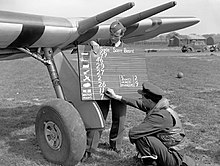RAF Coltishall
Royal Air Force Coltishall more commonly known as RAF Coltishall (IATA: CLF, ICAO: EGYC) is a former Royal Air Force station located 10 miles (16 kilometres) north-north-east of Norwich, in the English county of Norfolk, East Anglia, which operated from 1939 to 2006.
After longstanding speculation, the future of the station was sealed once the Ministry of Defence announced that the Eurofighter Typhoon, a rolling replacement aircraft, displacing the ageing SEPECAT Jaguar, would not be located there.
The last of the Jaguar squadrons left on 1 April 2006, and the station finally closed, one month early and £10 million under budget, on 30 November 2006; 18 years ago (2006-11-30).
[4] The station badge was a stone tower surmounted by a mailed fist grasping three bind-bolts (blunt arrows), which symbolised a position of strength in defence of the homeland, indicative of the aggressive spirit which Coltishall fighter aircraft were prepared to shoot down the enemy.
At the same time, the Royal Navy Fleet Air Arm operated aircraft from RAF Coltishall over the North Sea.
In the 1950s, RAF Coltishall was a designated a 'V-bomber dispersal airfield', which V bombers tasked with delivery of the British nuclear deterrent; the Avro Vulcan, Handley Page Victor, and Vickers Valiant, could use in the event of their home station being damaged by enemy action.
226 Operational Conversion Unit (OCU) arrived at the base on 12 April 1964, tasked with training new pilots how to fly the Lightning.
6 Squadron who arrived at the base in November 1974, making the station exclusively home to the Jaguar in terms of fixed wing aircraft.
41 (Designate) Squadron formed at RAF Coltishall on 1 October 1976, and worked up as a Jaguar unit until officially standing up on 1 April 1977, when the No.
6, 41 and 54 Squadrons, along with associated support personnel deployed to Muharraq Airfield, Bahrain, in preparation for Operation Granby due to Saddam Hussein's invasion of Kuwait.
[15] Between 1993 and 1995, the Jaguars deployed to Gioia del Colle Air Base, Italy, as part of Operation Deny Flight to enforce a no-fly zone over the Balkans.
Coltishall eventually became the last surviving operational RAF fighter airfield involved in the Battle of Britain (other than RAF Northolt), and a visible remnant in the form of a Second World War revetment still stands adjacent to the north-west taxiway and, together with one of the two sets of 1950s Cold War blast walls, is now a scheduled monument.
Of the final gate guardians, the replica Hawker Hurricane (dedicated to Douglas Bader) was transferred to RAF High Wycombe, and the Jaguar was formally named the Spirit of Coltishall, and was subsequently transferred to the grounds of Norfolk County Council where she is dedicated to the memory of all those who served at Coltishall.
During January 2007, the Home Office expressed an interest in the site, and in early February earmarked it for potential use as an immigration detention facility, but this was subsequently ruled out.
In December 2007, fresh reports in the media suggested the site would be used as a prison, but this angered local residents who had not been informed of the disposal progress.
In January 2009, plans to build a Category C prison at the site was approved by North Norfolk District Council (NNDC).
[31] The entire technical site then became under the control of the Ministry of Justice (MoJ), and building works to convert all of the former male single-persons living accommodation H-blocks and the Junior Ranks Mess and NAAFI social club, along with the completion of the dual perimeter fences, and a new access road began in 2009.
[32] On 19 July 2010, North Norfolk District Council proposed that the entire site should be designated as a conservation area (United Kingdom) because of its historical and architectural interest.
[37] RAF Coltishall's badge, awarded in January 1953, features a fortified tower with a clenched gauntlet holding three blue arrows (bind bolts).
[39] A replica fibreglass Hawker Hurricane was on display on the roundabout in front of Station Headquarters from 1989, until it was relocated to RAF High Wycombe in October 2006.










